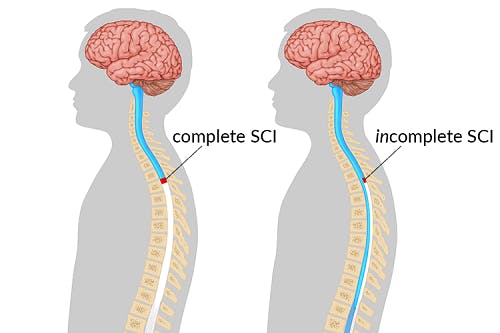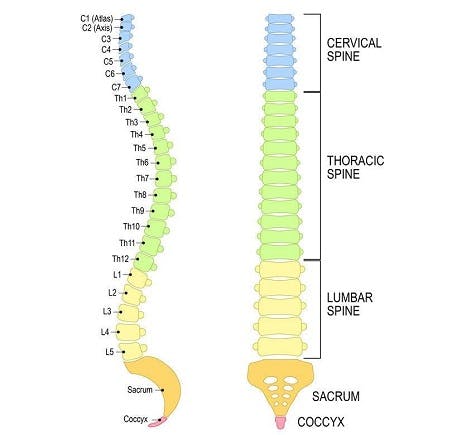Types of Spinal Cord Injury: Complete vs Incomplete, Levels, & ASIA Scale
There are many ways to classify the different types of spinal cord injuries. Some refer to the severity of the injury, while others refer to the level of injury.
To help you differentiate between multiple types of spinal cord injuries, this article will explain the various ways to classify an SCI and what they mean.
General Types of Spinal Cord Injury

There are two main types of spinal cord injuries: complete and incomplete. Completeness of injury refers to the severity of the spinal cord lesion. This is the most general way to classify spinal cord injuries. Depending on the completeness of injury, functional outcomes and recovery outlook can significantly vary.
In the following sections, we’ll discuss the major distinctions between these two types of spinal cord injuries.
Complete Spinal Cord Injury
A complete spinal cord injury is the result of a fully transected spinal cord. Generally, damage to the spinal cord cannot reverse itself. Therefore, with a complete injury, signals from the brain are not able to travel past the site of injury, because no spared neural pathways exist.
Likewise, sensory signals from areas innervated below the level of injury will be unable to reach the brain. As a result, individuals with complete spinal cord injuries experience both paralysis and loss of sensation below their level of injury.
Incomplete Spinal Cord Injury
The outcomes of incomplete types of spinal cord injuries can vary extensively. Incomplete spinal cord injury refers to a lesion that does not completely transect the spinal cord. As a result, some neural pathways will not be affected by SCI, which means individuals may be able to control or feel some areas innervated below their level of injury.
Depending on the severity of their spinal cord injury, the amount of preserved sensorimotor functions will vary. One major difference between complete and incomplete spinal cord injuries is that incomplete SCI patients are often capable of functional recovery because they have spared neural pathways at their level of injury.
Neuroplasticity is the central nervous system’s ability to rewire itself. Functions affected by incomplete injury can be reassigned to healthier regions of the spinal cord and strengthened through massed practice. However, neuroplasticity is limited. Generally, the less severe one’s SCI is, the more spared neural pathways they have, and the greater the recovery potential.
Now that you understand the differences between these two types of spinal cord injuries, let’s go over the various levels of injury.
Levels of Spinal Cord Injury

Whether it’s a complete or incomplete injury, every spinal cord injury can also be classified based on the level of injury. Level of injury refers to the lowest area of the spinal cord where motor and sensory functions are normal.
Determining the level of injury is essential to understand which functions can potentially be affected.
The spinal cord is protected by the spine and separated into 5 regions (from top to bottom):
- Cervical: consists of 8 nerve segments (C1-8) that innervate the neck, diaphragm, shoulders, arms, and hands
- Thoracic: consists of 12 nerve segments (T1-12) that innervate the chest, back, and abdominal muscles
- Lumbar: consists of 5 nerve segments (L1-5) that innervate some of the external genitalia and the legs
- Sacral: consists of 5 segments (S1-5) that innervate the legs, feet, and the rest of the genitalia
- Coccygeal: a single coccygeal nerve that innervates the skin around the tailbone
For both a complete and an incomplete spinal cord injury, determining one’s level of injury will help individuals understand what functions will or will not be affected.
Types of Spinal Cord Injuries According to the ASIA Impairment Scale (AIS)

Another common way to classify different types of spinal cord injuries is to refer to the ASIA impairment scale, which is a standardized neurological exam to determine the sensory and motor levels that were affected by SCI.
The ASIA impairment scale consists of 5 categories:
- AIS A indicates no motor and no sensory function remain below level of injury. All complete spinal cord injuries are AIS A, and this is the most severe ASIA level.
- AIS B refers to an incomplete injury where sensory function is preserved below level of injury, but no motor function remains.
- AIS C indicates an incomplete injury where sensory or motor function is preserved in the S4/5 segment.
- AIS D also describes an incomplete injury with partial motor function; however, those with AIS D have full range of motion against gravity for at least half of the key muscle functions below level of injury.
- AIS E refers to a full functional recovery. Generally, individuals will have recovered normal motor control and sensation below the level of injury, after previously having demonstrated deficits. (This indicates that individuals can move up in ASIA levels throughout their recovery, although this does not happen for everyone)
The ASIA classifications listed above have additional more detailed criteria that your physician(s) and therapist(s) may use to help understand your injury and predict your functional outcomes.
Instead of simply classifying a spinal cord injury as complete or incomplete, the ASIA impairment scale helps the rehab team understand the amount of sensorimotor functions a patient has.
Types of Spinal Cord Injuries: Key Points
Understanding the different types of spinal cord injuries is essential because it helps care providers recognize what functions may or may not be affected and create a personalized rehabilitation plan.
While the type of SCI plays a critical role in the rehabilitation process, there are also many controllable factors that can impact functional recovery.
For example, patients can control the intensity of their exercises, how much they move throughout the day, and what they eat. These factors can affect energy levels, circulation, and stimulate neuroplasticity in the spinal cord.
Hopefully, this article helped you better understand the various ways to classify a spinal cord injury. Good luck!
Keep it going: Get 15 pages of rehab exercises for SCI recovery in our FREE ebook

Get instant access to our free exercise ebook for SCI survivors. If you liked this post, you’ll LOVE our emails and ebook.
Each exercise features pictures of a licensed therapist to help guide you. You’ll also receive our popular recovery emails with SCI survivor stories and other useful tips — you can opt out anytime.
We will never sell your email address, and we never spam.
